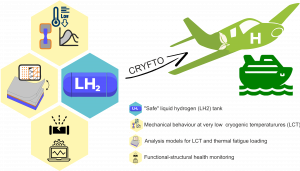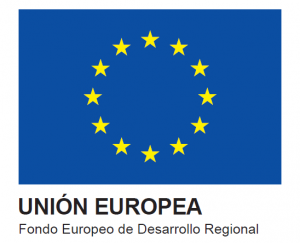CRYFTO

TowaRds the design of saFe liquid hYdrogen tanks for effiCient and green Transport applicatiOns

Period: 09/2022-08/2025 (36 months)
Project coordinator: Albert Turon and Jordi Renart
Participants: INTA Instituto Nacional de Técnica Aeroespacial

Principal investigators:
Albert Turon albert.turon@udg.edu
Jordi Renart jordi.renart@udg.edu
AMADE researchers involved in the project:
Quirze Abella, Narcís Seras, Jordi Llobet, Mayerlin Salgado
Funding by: » Agencia Estatal de Investigación” (AEI), “Ministerio de Ciencia e Innovación” (MCIN) and “Fondo Europeo de Desarrollo Regional” (FEDER) under reference MCIN/ AEI/10.13039/501100011033.


The everyday evidence of climate change advances and consequences, and their relation with the CO2 emissions, is prompting social and political claims to the transport industry to reduce their carbon-footprint. A radical shift in the transport industry is needed by introducing low-carbon propulsion technologies and/or new fuels, such as hydrogen, which does not produce CO2 emissions whatsoever, and non-CO2 emissions are limited to water vapour (and trace amounts of NOx, if combusted), which would mean a reduction of 60-70% of climate impact per flight.
Several challenges need to be addressed in order to make the hydrogen propulsion a reality, specially in the aeronautical sectors, where the bet is using hydrogen liquid, otherwise the volume needed and requirements for hydrogen gas storage make viable solutions very challenging if not impossible. The main challenge for using liquid hydrogen is that it needs to be stored and handled at low cryogenic temperature (20K). The material performance and analysis methods are not understood/developed for such conditions, nor the monitoring techniques for the assessment of the functional-structural integrity during the service life of the tank.
CRYFTO is aimed at providing the fundamental knowledge and tools for a safe liquid hydrogen tank design. Developments in three different areas will be addressed in view of the LH2 tank specificities and current state of the art:
– To understand and characterize the mechanical behavior at Low Cryogenic Temperatures (LCT) and under thermal cycling conditions.
– To develop analysis models for LCT and thermo-mechanical cyclic loading down to 20K.
– To develop instrumentation and analysis methods for functional-structural health monitoring during the service life of the tank.
These developments need very specific background and singular equipment, and this is how the CRYFTO project is set up, with the collaboration of two complimentary entities leading two highly coordinated subprojects.
One the one hand, the UdG group, project coordinator, worldwide leading expert in the development of test methods and characterization of advanced composites and bonded/multimaterial joints, and on the development of reliable analysis models under different loading conditions, but without expertise at low cryogenic temperature applications.
On the other hand, INTA group, which has the unique facility in Spain to perform tests at low cryogenic temperature for mechanical characterization. They started doing tests and developing measuring and monitoring techniques more than 20 years ago, providing a worldwide unique background.
The combination of the different expertise and background of the two groups will lead to advancements to provide fundamental knowledge on the mechanical performance, analysis models and functional-structural monitoring techniques for safe liquid hydrogen tanks and to increase energy efficiency, raw materials efficient use and reduce carbon footprint of transport vehicles.
The main socio-economic benefits of CRYFTO rely on the projects full alignment with the thematic priority 5: Climate, Energy and Mobility and with the heart of the European Green Deal, leading to the reduction of environmental footprint, decarbonization objective and towards a sustainable mobility helping to slow down the effects of climate change.
Summary of the subproject conducted by AMADE-UdG: The main contribution of UdG has been on the development of efficient experimental methods and techniques, as well as the development of reliable analysis models and strategies for uncertainty quantification and management. However, the developments already available typically cover static, dynamic and fatigue loading for a typical temperature range between -55ºC and 150ºC. However, there is a lack of development for applications at low cryogenic temperatures, which counterparts the current bet of the aeronautical industry of fuelling aircrafts using liquid hydrogen (at 20K) to significantly reduce their carbon footprint. UdG team will contribute to the development of test and data reduction methods for the characterization of the fracture behaviour of the material at low cryogenic temperatures, and on the formulation of analysis models able to predict the structural behaviour to aid the design and certification process of new components such as a liquid hydrogen tanks.